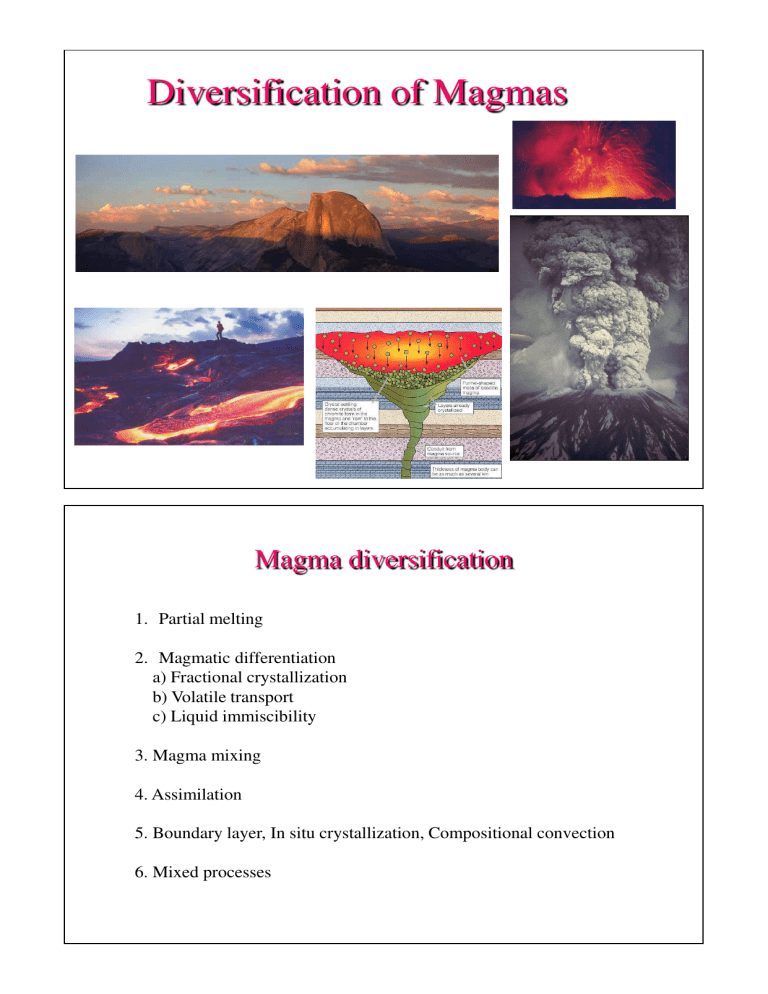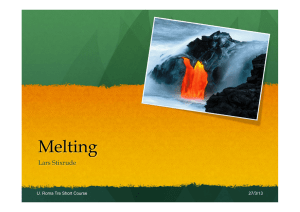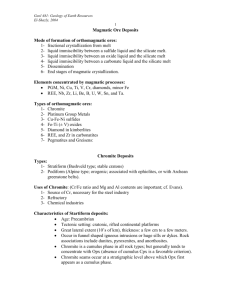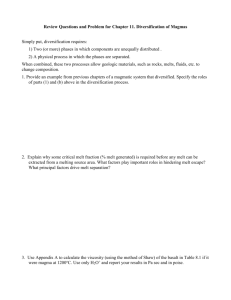
Diversification of Magmas Magma diversification 1. Partial melting 2. Magmatic differentiation a) Fractional crystallization b) Volatile transport c) Liquid immiscibility 3. Magma mixing 4. Assimilation 5. Boundary layer, In situ crystallization, Compositional convection 6. Mixed processes Magmatic Differentiation Any process by which a magma is able to diversify and produce a magma or rock of different composition Magmatic Differentiation Two essential processes 1. Creates a compositional difference in one or more phases As elements partition themselves in response to a change in an intensive variable, such as pressure, temperature, or composition This will determine the trend of the differentiation process 2. Preserves this chemical difference by segregating (or fractionating) the chemically distinct portions so that they may either form a rock, or continue to evolve as separate systems The effectiveness of the fractionation process determines extent of differentiation proceeds along a particular trend Most common: differentiation involving the physical separation of phases in multi-phase systems The effectiveness depends upon contrasts in physical properties such as density, viscosity, diffusivity, and size/shape The energy is usually thermal or gravitational The phases that are fractionated in magmatic systems can be either liquidsolid, liquid-liquid, or liquid-vapor Partial Melting Separation of a partially melted liquid from the solid residue Involves the partitioning of chemical constituents Can produce a variety of melt compositions from a single source Effects of removing liquid at various stages of melting Eutectic systems First melt always = eutectic composition Major element composition of eutectic melt is nearly constant until one of the source mineral phases is consumed (trace elements differ) Once a phase is consumed, the next increment of melt will be different X and T Trace element behavior: several models for crystallization and melting (batch melting, Rayleigh fractional melting...) X of a melt produced by partial melting of a particular source is a function of the pressure, temperature (the fraction of the source that is melted) Separation of a partially melted liquid from the solid residue requires a critical melt % Sufficient melt must be produced for it to Form a continuous, interconnected film Have enough interior volume that it is not all of it is adsorbed to the crystal surfaces Viscosity also important factor Gravitational effects (buoyant liquid) Filter pressing, or compaction, of crystal mush Sheared systems - the RCMP (rheological critical melt percentage) drops considerably RCMP varies with T viscosity X RCMP= % melt at which a crystal-dominated, high viscosity granular framework gives way to a melt-dominated, lower viscosity suspension Filter pressing • Interstitial liquid is separated from the crystals by pressure. ES450A-IKC-ES-IITK-2021 • As crystals grow and accumulate in a magmatic body, a crystal mesh may be formed, with the remaining liquid distributed in the interstices. 10 ES450A-IKC-ES-IITK-2021 11 Crystal Fractionation Dominant mechanism by which most magmas, once formed, differentiate? Segregation, Dissemination, Injection Gravity settling The differential motion of crystals and liquid under the influence of gravity due to their differences in density Gravity settling Cool point a olivine layer at base of pluton if first olivine sinks Next get ol+cpx layer finally get ol+cpx+plag Cumulate texture: Mutually touching phenocrysts with interstitial crystallized residual melt Dissemination Polybaric Fractional Crystallization 1. Stability of phases changes (hi-P garnet...) 2. Shift of the eutectic point with pressure will cause the quantity of the liquidus phases to vary Esp. increase in the size of the olivine field with decreasing pressure much more olivine forms as the melt composition follows the liquidus away from the olivine side of the phase diagram High-P (purple tieline) has liq > ol Hi-P Low-P Low-P (blue tie-line) has ol > liquid Ol Pyx Expansion of olivine field at low pressure causes an increase in the quantity of crystallized olivine Thus, the amount of olivine that crystallizes with a rising basaltic magma will be greater that the amount that forms during isobaric crystallization Two other mechanisms that facilitate the separation of crystals and liquid 1. Compaction Compaction (mentioned in reference to partial melting) is also quite possible in crystal mushes that form as cumulates or suspended crystals 2. Flow segregation Figures 11.4 and 11.5 Drever and Johnston (1958). Royal Soc. Edinburgh Trans., 63, 459-499. The motion of the magma past the stationary walls of the country rock creates shear in the viscous liquid Magma must flow around phenocrysts, thereby exerting pressure on them at constrictions where phenocrysts are near one another or the contact grain dispersive pressure, forcing the grains apart and away from the contact Volatile Transport 1. Vapor released by heating of hydrated or carbonated wall rocks 2. As a volatile-bearing (but undersaturated) magma rises and pressure is reduced, the magma may eventually become saturated in the vapor, and a free vapor phase will be released From Burnham and Davis (1974). A J Sci., 274, 902-940. Late-stage fractional crystallization Fractional crystallization enriches late melt in incompatible, LIL, and non-lithophile elements and volatile phases Many concentrate further in the vapor Particularly enriched with resurgent boiling (melt already evolved when vapor phase released) Get a silicate-saturated vapor + a vapor-saturated late derivative silicate liquid The vapor phase concentrates volatile constituents such as H2O, CO2, S, Cl, F, B, and P, as well as a wide range of incompatible and chalcophile elements (esp LILs) Volatile release raises liquidus temperature porphyritic texture May increase P - fracture the roof rocks Vapor and melt escape along fractures as dikes Silicate melt quartz and feldspar small dikes of aplite Vapor phase dikes or pods of pegmatite Concentrate incompatible elements Complex: varied mineralogy May display concentric zonation Figure 11.6 Sections of three zoned fluid-phase deposits (not at the same scale). a. Miarolitic pod in granite (several cm across). b. Asymmetric zoned pegmatite dike with aplitic base (several tens of cm across). c. Asymmetric zoned pegmatite with granitoid outer portion (several meters across). From Jahns and Burnham (1969). Econ. Geol., 64, 843-864. Liquid Immiscibility Liquid immiscibility in the Fo-SiO2 system Figure 6.12. Isobaric T-X phase diagram of the system Fo-Silica at 0.1 MPa. After Bowen and Anderson (1914) and Grieg (1927). Amer. J. Sci. Oil and water don’t mix at some T 25 As magmas cool, they can split into two liquids of different composition and density. One of these liquids is the silica-rich melt. It has the most volume The other, typically much smaller in volume, can be rich in metal oxides, sulfides or carbonates. 26 Some Examples Late silica-rich immiscible droplets in Fe-rich tholeiitic basalts Sulfide-silicate immiscibility (massive sulfide deposits) Carbonatite-nephelinite systems






